 The German Mittelstand is a highly successful business model that operates on a country level. Only this type of innovation works for an economy well in a long term. Think of it as “the whole-of-business innovation”. But can it be the winning business model for Australia?
The German Mittelstand is a highly successful business model that operates on a country level. Only this type of innovation works for an economy well in a long term. Think of it as “the whole-of-business innovation”. But can it be the winning business model for Australia?
The whole-of-business innovation concept is based on holistic thinking about ongoing competitiveness and market relevance of a business. As the ‘big’ business continues to rationalize, i.e. the job growth from this sector is close to negative, we need to focus on the 80/20 principle and apply it to Australian SMEs. This is were the future prosperity of this country is, including smart job creation and sustainable economic strength. But we need to get a few things RIGHT!
Since 2007 InnoFuture has been evangelizing business innovation trends and knowledge, sharing global insights from innovative leaders. But it’s not enough. Australia is way behind where we should be in competing globally. Yes, globally. Today, competitors in every area of activity are sailing, like a great flotilla, towards our shores. The ability to compete globally in order to beat competition on our own turf, is the only way to survival.
What is Mittelstand?
Recently I attended a German-Australian business conference in Melbourne, intrigued by the promised presentation on the German Mittelstand [read ‘mittel-shtaand’], a type of business that, through their high concentration in Germany, account for the global success of that country’s economy.
Together with the big household brands, including four of the world’s best known luxury cars: Benz, BMW, Audi and Porsche, the Mittelstand companies reinforce the reputation of German brand culture. It stands for quality and reliability, it delivers value and commands and justifies the premium price. No questions asked.
A special term, the Hidden Champions, has been coined for this business phenomenon by Professor Hermann Simon. Simon has published over 30 books in 25 languages, including Power Pricing (New York 1997), Manage for Profit, Not for Market Share (Boston 2006), and Beat the Crisis (New York 2010).
He is one of the Top 10 Management Thinkers and the most influential management thinker in the German language after the late Peter Drucker. In his bestseller, Hidden Champions of the 21st Century, Success Strategies of Unknown World Market Leaders (New York 2009) Simon investigates the strategies of little known market leaders.
While acknowledging concept and findings in this article stem from Professor Simon’s presentation, I have included comments to re-direct management thinking to Australian situation.
So, what’s the story with this The Hidden Champions? What are they? Why are they successful? And, importantly, what’s in it for you and to the 97% of Australian businesses (that’s how many SMEs make up Australian business landscape)?
Definition of a Hidden Champion
The term refers to a small to medium-size business – often family and privately owned – that, according to Simon, meets these three criteria:
- It is in the Top 3 in the world or number 1 on its continent.
- Revenue is less than €5 billion. Don’t panic, they all started small!
- Not well known to the general public; not a household name.
So, what makes them successful?
Six Characteristics of Hidden Champions
1. Extremely Ambitious Goals and Long-term Vision
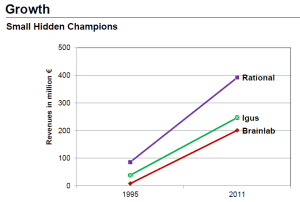 Success always begins with ambitious goals. The Hidden Champions go for growth and market leadership. This is the fuel that drives them forward. The graph shows growth in three small companies, but the rate of growth is similar for medium and small Hidden Champions.
Success always begins with ambitious goals. The Hidden Champions go for growth and market leadership. This is the fuel that drives them forward. The graph shows growth in three small companies, but the rate of growth is similar for medium and small Hidden Champions.
Their strong, compelling Vision is not an advertising statement. It is a public commitment to achieving it – shared with the world, including their employees. As a result of having and communicating such goal, their highly qualified and trained employees know that they are not just “laying another brick, but building a cathedral” that will withstand the changing times.
“The goal of Chemetall is the worldwide technology and marketing leadership.” Chemetall is the world market leader in special metals like lithium and caesium.
2. Narrow Focus and Deep Expertise
 Would you stack the chances of global success on ONE product, let alone at a dog leash?
Would you stack the chances of global success on ONE product, let alone at a dog leash?
“We only focus on one thing, but we do it better than anyone else” – Flexi is the world market leader in retractable dog leashes.
“Only focus leads to world class. The Hidden Champions are highly focused on their technologies and their markets. Through a deep value chain they create unique products and protect their know-how,” says Professor Simon.
The Mittelstand companies do not outsource core competencies. They always own machine shops and are very secretive in R&D. A Deep Value Chain becomes a platform for consistent quality and superior, growing know-how. Their proprietary knowledge does not easily disappear with staff or external suppliers.
“We always had one customer and we will only have one customer in the future: the pharmaceutical industry. We only do one thing, but we do it right” – Uhlmann is the world market leader in packaging systems for the pharmaceutical industry.
“We produce all parts ourselves, based on the quality standards we define,” Wanzl.
“As many parts as possible are self-produced, all of which takes place in a small region with down-to-earth people,” Miele.
3. Closeness to Customer
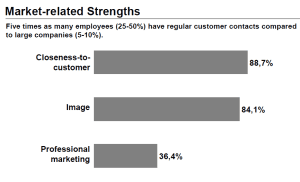 “We lead by expecting our customers’ expectations. Leadership means becoming the benchmark for others. We set the standards on the world market.” Sick is a world market leader in sensors.
“We lead by expecting our customers’ expectations. Leadership means becoming the benchmark for others. We set the standards on the world market.” Sick is a world market leader in sensors.
For Mittelstand business profit is not the objective. It is inevitable by-product of serving customers better then anyone else. While in large companies only 5-10% of employees have a regular customer contact, for Mittelstand it’s 25-50%. Based on this knowledge these businesses develop high value, hard to copy solutions for their customers. Their strategy is value-driven, not price-driven resulting in quality of Product/Service for which customers are willing to pay premium.
This closeness to and understanding of the customer and clarity of what their business offering, empowers employees to make virtually any decision on their own – making them more efficient.
4. Globalization
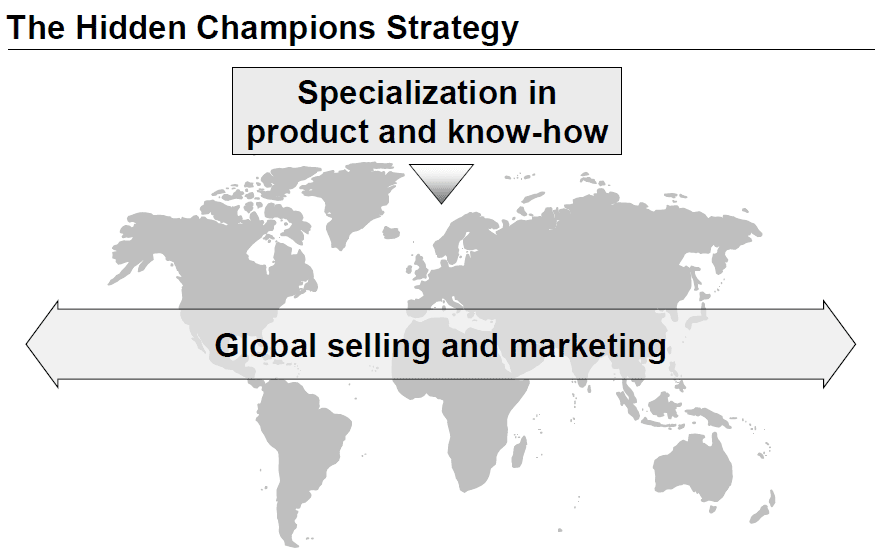 The Hidden Champions combine specialization in product and know-how with global selling and marketing. Globalization is the growth booster for them. They serve the target markets through their own subsidiaries.
The Hidden Champions combine specialization in product and know-how with global selling and marketing. Globalization is the growth booster for them. They serve the target markets through their own subsidiaries.
There are two points to note about this approach in terms of marketing and innovation leadership:
- These product and technology companies are ‘quality solution’ marketers rather than gloss and brand-name marketers. Brand name comes with earned reputation where it matters – in the right markets. That’s why their marketing is more effective and more profitable.
- By using subsidiaries, they exercise stronger control of their product delivery and remain closer to the customer. Hence, the other source of successful marketing and more clear focus for innovation and purposeful R&D.
5. Innovation through core focus
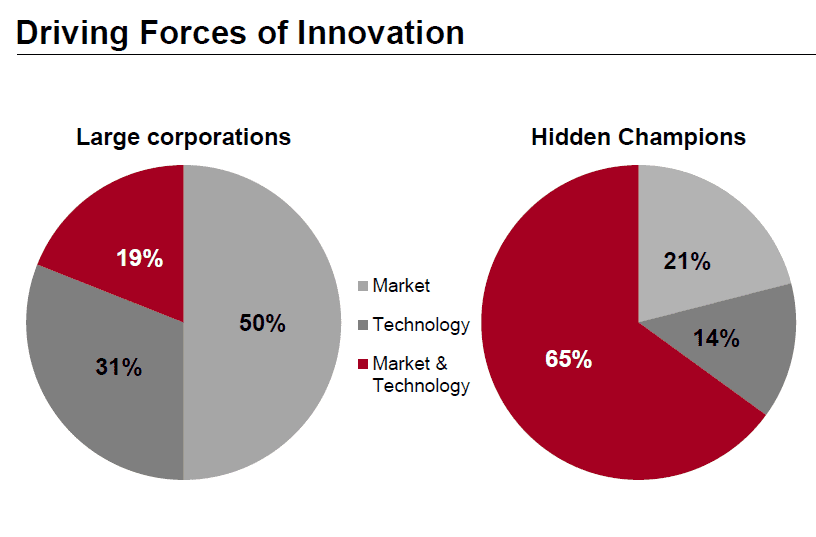 “Innovativeness and closeness to customer are the greatest strengths of the Hidden Champions. Their strategies are value-oriented, not price-oriented. The Hidden Champions hold strong competitive positions. Advice, systems integration and ease of use are new advantages which create higher barriers to entry,” says Professor Simon.
“Innovativeness and closeness to customer are the greatest strengths of the Hidden Champions. Their strategies are value-oriented, not price-oriented. The Hidden Champions hold strong competitive positions. Advice, systems integration and ease of use are new advantages which create higher barriers to entry,” says Professor Simon.
As a result of these value-driven, not price-driven strategies, the Mittelstand companies can command premium price and successfully avoid price wars.
Investment in R&D
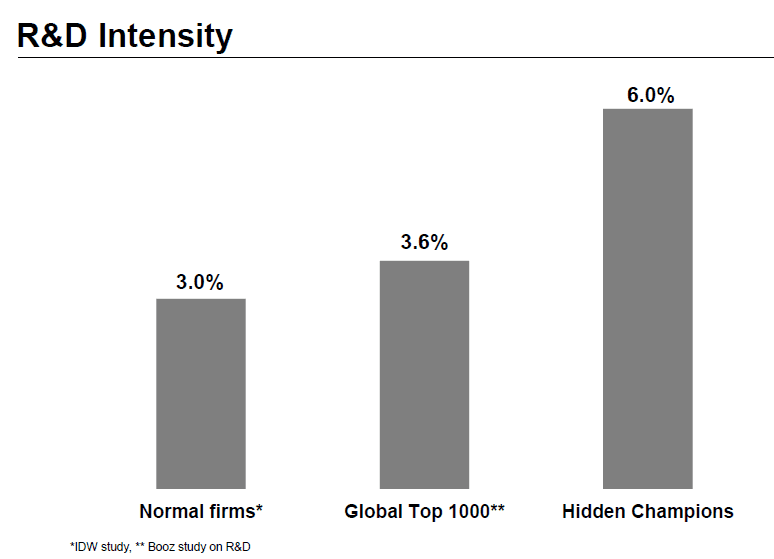 Here is an important difference in the role of R&D in German Hidden Champion companies: they invest nearly twice as much as ‘normal’ or even the ‘global top 1000’ companies. But because they have a strong and narrow focus and closeness to the customers, they get higher returns from their investment.
Here is an important difference in the role of R&D in German Hidden Champion companies: they invest nearly twice as much as ‘normal’ or even the ‘global top 1000’ companies. But because they have a strong and narrow focus and closeness to the customers, they get higher returns from their investment.
Statistics show that the cost per Patent for Hidden Champions is approximately 80%, or five times lower than in large corporations.
In addition to manufacturing their own high quality, unique products, Mittelstanders usually develop in-house the machinery and test equipment that builds those products. This ensures higher lever of quality and reliability and lower cost of production. Having developed their own equipment enables them to repair, improve and replace without the expense of bringing in external suppliers. Plus, it puts another barrier for their competitors.
And, because the knowledge remains and grows inside and the decision-making cycles are shorter and more focused. These uber-innovators generate a high proportion of Patents, further leveraging their R&D to improve their competitive advantage.
6. People Culture: Employees and Leaders
But the real source of the success of Hidden Champions is their Culture: People.
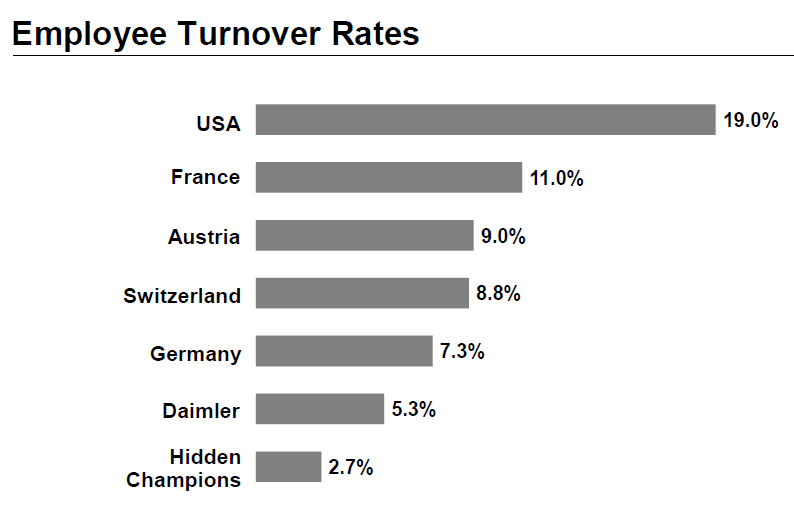 Employees
Employees
On the employee front the Hidden Champions have “more work than heads” and high performance cultures derived from employing highly qualified staff and relentlessly training the workforce in vocational skills. Combined with the clarity of purpose and pride in the work, turnover and sickness rates are extremely low.
Leaders
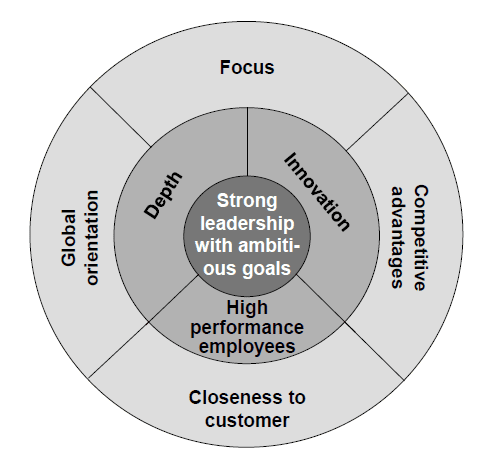 In terms of Leadership, the Hidden Champions have a strong identity of people and purpose. They are conservative in strategy, i.e. unwavering in their focus, but highly participative and flexible in the details’ management.
In terms of Leadership, the Hidden Champions have a strong identity of people and purpose. They are conservative in strategy, i.e. unwavering in their focus, but highly participative and flexible in the details’ management.
They also operate on the philosophy of ‘stewardship’: to the company, employees, customers and the community in which they operate. And, they often operate in small, regional towns. They take a long-term view of their responsibility to their families and those local communities and their customers.
According to Professor Simon’s findings, leaders come young into power, there are more women in top positions and the continuity of leadership is very high: Hidden Champions: 20 years; Large corporations: 6.1 years. Compare these facts to the situation in this country!
Lessons for the Australian Business Model
Australia should not only build its future on Fortune Global 500 companies, of which it has 8, but develop a large number of Hidden Champions. It has about a dozen today. With the same per capita number as Germany, Australia would have 360 Hidden Champions.
Importantly, these six characteristics apply to any business that recognises the importance of creating value around its competitive advantage. Like fingerprints, no two companies can have the same competitive advantage. And, here lies the secret to success! Each business just needs to find and leverage its competitive advantage.
Finding a competitive advantage is the key objective of business and marketing strategy. If your marketing manager or your content marketer is not asking this question, or working to find the answer, you have a problem.
There is no need to copy Apple or adopt the ‘Toyota way’ or other ready-to-wear consulting business models that do not translate into your competitive strategy.
The bottom line is that the success of the ‘Mittelstand’ is a powerful and viable lesson for Australian business. Think it through and you can start making a difference today!
To find out how InnoFuture can help you transform your Business into a globally competitive, innovative Brand…
Book a Discovery Call with InnoFuture to discuss your Business Challenge. InnoFuture provides innovative business culture transformation services to progressive Australian businesses and organisations: Business Culture | Business Branding | Innovation Capacity.
InnoFuture provides innovative business culture transformation services to progressive Australian businesses and organisations: Business Culture | Business Branding | Innovation Capacity.
For for urgent help call Margaret Manson: 0407 66 11 30 0407 66 11 30..
0407 66 11 30..
Sign up to the IN-CROWD list – below – and stay connected with the Next innovation trends and to the local and global innovation thought leadership.
